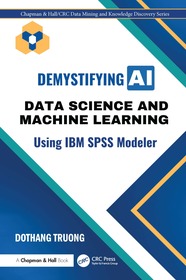
Demystifying AI
Data Science and Machine Learning Using IBM SPSS Modeler
Series: Chapman & Hall/CRC Data Mining and Knowledge Discovery Series;
- Publisher's listprice GBP 89.99
-
42 992 Ft (40 945 Ft + 5% VAT)
The price is estimated because at the time of ordering we do not know what conversion rates will apply to HUF / product currency when the book arrives. In case HUF is weaker, the price increases slightly, in case HUF is stronger, the price goes lower slightly.
- Discount 10% (cc. 4 299 Ft off)
- Discounted price 38 693 Ft (36 851 Ft + 5% VAT)
Subcribe now and take benefit of a favourable price.
Subscribe
42 992 Ft

Availability
Not yet published.
Why don't you give exact delivery time?
Delivery time is estimated on our previous experiences. We give estimations only, because we order from outside Hungary, and the delivery time mainly depends on how quickly the publisher supplies the book. Faster or slower deliveries both happen, but we do our best to supply as quickly as possible.
Product details:
- Edition number 1
- Publisher Chapman and Hall
- Date of Publication 16 December 2025
- ISBN 9781032740003
- Binding Hardback
- No. of pages616 pages
- Size 254x178 mm
- Weight 453 g
- Language English
- Illustrations 6 Illustrations, black & white; 647 Illustrations, color; 29 Halftones, color; 6 Line drawings, black & white; 618 Line drawings, color; 151 Tables, black & white; 15 Tables, color 700
Categories
Short description:
This book is designed to cater to readers who prefer a hands-on guide using SPSS Modeler, a widely popular software that does not require coding or programming skills. It targets a broad audience, including students, lecturers, researchers, and industry professionals.
MoreLong description:
As artificial intelligence advances at an exponential pace, understanding data science and machine learning has become increasingly essential. Yet, the wide range of available resources can be daunting, posing challenges for beginners. This second book builds on the foundation laid in the first, Data Science and Machine Learning for Non-Programmers: Using SAS Enterprise Miner, providing similar fundamental knowledge of data science and machine learning in an accessible way. It is specifically designed to cater to readers who prefer a hands-on guide using IBM SPSS Modeler, a widely popular software that does not require coding or programming skills. Like the first book, this volume helps learners from various non-technical fields gain practical insight into machine learning but shifts the focus to a different tool for those seeking alternatives to coding.
In this book, readers are guided through practical implementations using real datasets and IBM SPSS Modeler, a user-friendly data mining tool. The approach remains consistent with a focus on application, providing step-by-step instructions for all stages of the data mining process using two large datasets, ensuring continuity and reinforcing concepts in a cohesive project framework. This book also offers practical advice on presenting data mining results effectively, aiding readers in communicating insights clearly to stakeholders.
Together with the first book, this volume is a companion for beginners and experienced practitioners alike. It targets a broad audience, including students, lecturers, researchers, and industry professionals. It offers flexibility in learning pathways and deepens understanding of data science using easy-to-follow, software-based approaches.
MoreTable of Contents:
PART I Introduction to Data Mining
Chapter 1 Introduction to Data Mining and Data Science
Chapter 2 Data Mining Processes, Methods, and Software
Chapter 3 Data Sampling and Partitioning
Chapter 4 Data Visualization and Exploration
Chapter 5 Data Modification
PART II Data Mining Methods
Chapter 6 Model Evaluation
Chapter 7 Regression Methods
Chapter 8 Decision Trees
Chapter 9 Neural Networks
Chapter 10 Ensemble Modeling
Chapter 11 Presenting Results and Writing Data Mining Reports
Chapter 12 Principal Component Analysis
Chapter 13 Cluster Analysis
PART III Advanced Data Mining Methods
Chapter 14 Random Forest
Chapter 15 Gradient Boosting
Chapter 16 Bayesian Networks
Appendix A
Appendix B
Appendix C
More




